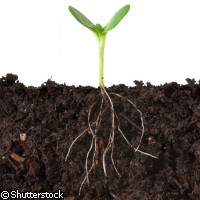Getting to the root of plants
A diverse team of researchers from Europe, Asia and the USA has unearthed new information on how roots grow and develop. Specifically, how roots are able to move sideways out of the central root and into the soil. Their discovery has opened the way to further research that may eventually lead to the creation of new crops with improved root structure, improving their chances of survival in difficult soils. Roots provide the crops we eat with water and nutrients. They serve as a firm anchor, keeping them in place against violent winds, and as a place to store food against leaner times. All these attributes have made agricultural farming possible. A paper recently published in Nature Cell Biology has revealed for the first time how lateral root emergence is achieved. Their findings show that new lateral roots are actually able to 're-programme' the cells that overlay them; this ability causes them to separate thereby enabling the new root to emerge. Lateral roots, as their name suggests, extend horizontally from the primal root, otherwise referred to as parent root, helping the plant to anchor itself in the soil. Their first mission is to pass through several layers of tissue before they can enter the soil. Once they have entered the soil they then branch out sideways looking for nutrients and water to help the plant sustain itself. As they extend through the soil, the roots show a wide variation in the way they grow through the soil to exploit the available resources. Olive trees for example, have been known to extend their roots laterally several meters out from their trunk. Without the roots offering stability and providing nutrients, the plant would die. This research was led by the Centre for Plant Integrative Biology at the UK's University of Nottingham, which approached this challenge from a holistic point of view. They were able to bring together students from different disciplines such as mathematics, engineering and computer science, as well as plant sciences, and together they were able to study root development at different levels, from the molecular, cellular to the organ levels. Lateral root growth is achieved when the plant hormone auxin (from the Greek word auxano, to grow) acts as a local inductive signal which re-programmes adjacent cells. Auxin then induces the expression of LAX3, which in turn promotes the induction of cell-wall- remodelling enzymes. This results in increased cell separation, allowing the lateral roots to move out. Professor Malcolm Bennett, who is the Biology Director for the Centre for Plant Integrative Biology and Head of Division of Plant and Crop Sciences, believes that thanks to the study's initial revelation on lateral roots, researchers were able to continue on from this and find out a whole lot more. Speaking about the research paper he commented that: 'In addition to providing new biological insight into lateral root emergence, we have identified a large number of genes that control this process. This is really important because this may enable us to breed crops with improved root architecture in the future.' This achievement was made by an international consortium involving more than 20 scientists from laboratories based in Belgium, France, Germany, Spain, Sweden, USA and UK.



